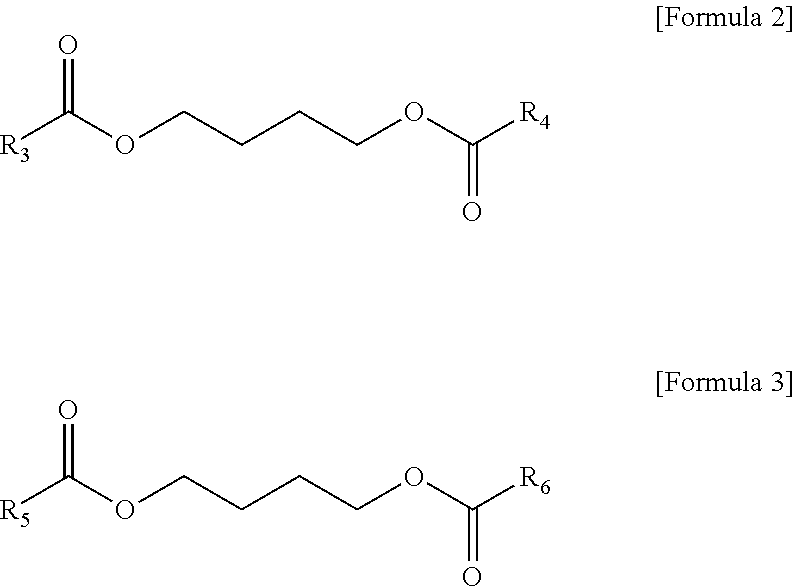Plasticizer and polyvinyl chloride resin composition containing same
a polyvinyl chloride resin and plasticizer technology, applied in the field of ester compound and plasticizer comprising the same, can solve the problems of reducing the use of phthalate plasticizers in the field of plasticizers used in food, drinks, medical supplies and medicines, and achieve excellent plasticizing efficiency, improve physical properties such as tensile strength and the like of products
- Summary
- Abstract
- Description
- Claims
- Application Information
AI Technical Summary
Benefits of technology
Problems solved by technology
Method used
Image
Examples
example 1
Preparation of an ester plasticizer using 1,4-butanediol, benzoic acid and decanoic acid
[0034]First, 1.0 mol of 1,4-butanediol, 1.0 mol of benzoic acid, 1.0 mol of decanoic acid, 200 g of toluene as a solvent, and 3.0 g of sodium bisulfate as a catalyst were put into a 2 L round flask provided with a stirrer and a condenser, and were then heated to 130° C. to conduct a reaction for 12 hours.
[0035]After the reaction, unreacted organic acid and acid catalyst were neutralized by 10 wt % of an aqueous sodium carbonate solution, water-washed, dewatered and then filtered by an adsorbent to obtain an ester plasticizer including benzoic acid 4-decanoyloxy-butyl ester (about 50 wt %) as a main component.
[0036]Preparation of a Polyvinyl Chloride Resin Composition
[0037]Test samples were fabricated in order to evaluate the performance of the obtained ester plasticizer. That is, 50 phr of the obtained ester plasticizer including benzoic acid 4-decanoyloxy-butyl ester as a main component and 1 ph...
example 2
[0039]An ester plasticizer and a polyvinyl chloride resin composition were prepared in the same manner as Example 1, except that octanoic acid was used instead of decanoic acid. The test results thereof are given in Table 1 below.
example 3
[0040]An ester plasticizer and a polyvinyl chloride resin composition were prepared in the same manner as Example 1, except that dodecanoic acid was used instead of decanoic acid. The test results thereof are given in Table 1 below.
PUM
| Property | Measurement | Unit |
|---|---|---|
| Tensile strength | aaaaa | aaaaa |
Abstract
Description
Claims
Application Information
 Login to View More
Login to View More - R&D
- Intellectual Property
- Life Sciences
- Materials
- Tech Scout
- Unparalleled Data Quality
- Higher Quality Content
- 60% Fewer Hallucinations
Browse by: Latest US Patents, China's latest patents, Technical Efficacy Thesaurus, Application Domain, Technology Topic, Popular Technical Reports.
© 2025 PatSnap. All rights reserved.Legal|Privacy policy|Modern Slavery Act Transparency Statement|Sitemap|About US| Contact US: help@patsnap.com



